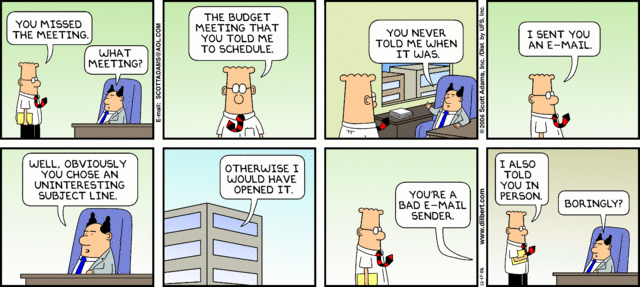One of the biggest email communication problems is poorly written subject lines. Here are five ways you can improve them.
If you use email, chances are that you will recognize the following scenario (or a similar version of it):
Funny and a bit over-the-top? Sure. But this cartoon has some truth in it. Email subject lines are more important that you might think.
The subject line is the first thing your reader sees, and it can provide substantial clues regarding the content of your email and what action you are expecting. Vague, nondescript subjects such as “Hi” don’t help the reader understand what you are trying to accomplish.
Instead, follow these tips for writing good email subject lines (several of these tips are from the Business Insider's article 15 Tips For Writing An Excellent Email Subject Line):
Tip #1- Connect your subject line to your message; save “hello” for the body of the email.
You don't have much room to grab the reader's attention. So keep it short. Most email subject lines only display about 60 characters, and a mobile phone only shows about 25 to 30 characters. So keep it short and aim for a length of six to eight words. Don't waste precious space with the generic word "hello."
#2 - Be specific.
If you are setting a meeting at 10:00 a.m. on Monday, include this information in your subject line rather than just the word “meeting.”
"The subject line should communicate exactly what the email is about," says the Business Insider, "so that the recipient can prioritize the email’s importance without having to open it." Avoid anything that sounds vague. You can never be too clear.
#3 - Ask for the expected response.
Do you want someone to review a document or RSVP for a meeting? State it in the subject: “Please review” or “Please RSVP.” If you want to avoid being frustrated by NOT getting a response, then you need to ask for one directly.
Or you can just add a deadline to the subject line. "Especially if you have a lot of information to convey in the email itself," says the Business Insider, "including a deadline right in the subject line exponentially increases the odds that readers will respond."
(In addition, it's courteous to let your recipient know if you do NOT need a response. You can add phrases like "no response needed" or "FYI" to make it clear.)
#4 - DO NOT YELL AT PEOPLE.
It's true: writing everything in capital letters is equal to shouting out loud. It's easy enough for people to misinterpret an email or feel that the message is uncivil (when that wasn't the intention), so be as courteous and polite as possible. "The writer's job is not to give recipients anxiety about a message," says the Business Insider, "but make it as easy as possible for them to read it."
#5 - Tailor the subject line to each recipient.
To stand out from the many emails your recipient probably gets every day, try personalizing the subject line. Use their name or their company's name to grab their attention. If the recipient sees that the email is about them or a topic they're interested in, they will be more likely to open your email.
Want a few more tips on powering up your email communication skills? Check out our free eBook!







Leave a Comment